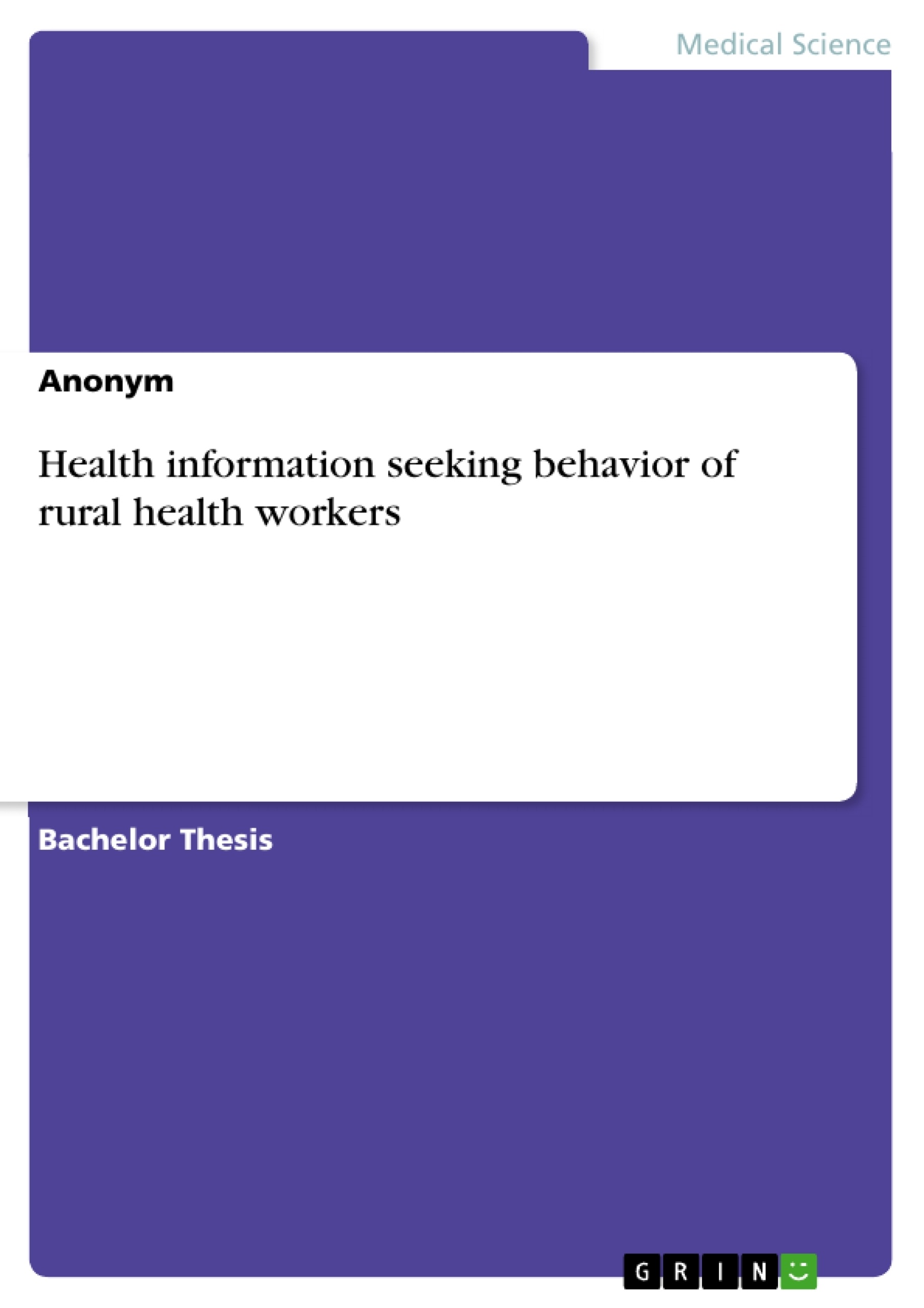Information is inevitable in the health profession. The need to become informed and knowledgeable which leads to “information seeking behaviour processes” is important among qualified health workers who have vital roles in achieving health goals of a given country. The purpose of this study was to investigate the health information seeking behaviour of rural health workers in Karonga, Malawi. Specifically, the study determined the health information needs; awareness of health information sources; ascertained the health information sources consulted; the benefits of consulting health information sources; and establish the challenges faced by rural health workers in accessing. The study used a cross-sectional study design employing quantitative method. Purposive sampling was used to select a study sample of 50 health workers to participate in the study. The collected data was analysed descriptively using IBM SPSS version 20. Results showed that almost all study participants (96%) had an information need. Their needs included updates on new health issues, need to provide quality of service and need to upgrade knowledge. The study found that majority of rural health workers 46(92%) were aware of information sources. The study also revealed that the major information sources accessed by rural health workers were both print and electronic sources which included reference materials, text books, and online databases among others. The study also showed that the majority (52%) of respondent’s preferred accessing health information at their respective hospital offices. The sampled health workers cited lack of hospital libraries, funding, inadequate and poor ICT facilities, and outdated health information resources as major challenges. From the findings, it is evident that health information seeking behaviour is poor. Therefore, the study recommends that there should be supportive policies, improved ICT infrastructure, increased funding and advocacy for development of libraries in rural health facilities.
.
Inhaltsverzeichnis (Table of Contents)
- DEDICATION
- Acknowledgements
- Acronyms
- Abstract
- CHAPTER ONE: INTRODUCTION
- 1.1 Background information.
- 1.2 Case description..........\n
- 1.3 Statement of the problem
- 1.4 Aim of the study.
- 1.5 Specific Objectives
- 1.6 Research Questions
- 1.7 Significance of the study
- 1.8 Conceptual Framework
- 1.8.1 Wilson's Model of Information seeking.....
- 1.9 Scope and limitations of the study.
- 1.10 Synopsis ..........\n
- CHAPTER TWO: LITERATURE REVIEW..\n
- 2.1 Introduction .........\n
- 2.2. Information Needs..\n
- 2.3 Awareness and health information sources...\n
- 2.4 Benefits of consulting health information sources.\n
- 2.5 Challenges to Seeking Health Information
- 2.6 Healthcare delivery System in Malawi......\n
- 2.7 Synopsis....\n
- CHAPTER 3: METHODOLOGY
- 3.1 Introduction ..........\n
- 3.2 Research design.
- 3.3 Study area
- 3.4 Sampling technique.…………………..\n
- 3.5 Instrumentation and procedures of data collection...........\n
- 3.5.1 Questionnaire
- 3.6 Data Collection .....\n
- 3.7 Data Analysis..\n
- 3.8 Ethical Consideration...\n
- 3.10 Dissemination of Results.\n
- CHAPTER FOUR: DATA ANALYSIS, PRESENTATION AND INTERPRETATION OF FINDINGS AND RESULTS.\n
- 4.2 Response rate
- 4.3 Demographic profiling.....\n
- 4.4 Health information needs........\n
- 4.5 Awareness of health information sources
- 4.5.1 General awareness of health information sources..\n
- 4.5.2 Types of health information sources that they were aware of ……………………………..
- 4.5.3 Source of awareness of health information sources
- 4.5.4 Level of proficiency
- 4.6. Health information sources consulted by rural health workers...\n
- 4.6.1 Format preferences in accessing health information sources\n
Zielsetzung und Themenschwerpunkte (Objectives and Key Themes)
This research aims to explore the health information seeking behaviour of rural health workers in Karonga District, Malawi. The study seeks to understand their information needs, awareness of various health information sources, and the challenges they face in accessing and utilizing these resources. Key themes explored in this research include:- Health Information Needs of Rural Health Workers
- Awareness of Health Information Sources
- Factors Influencing Health Information Seeking Behavior
- Challenges in Accessing and Utilizing Health Information
- The Role of Health Information in Rural Healthcare Delivery
Zusammenfassung der Kapitel (Chapter Summaries)
Chapter One introduces the research topic by providing background information on the importance of health information seeking in rural communities. It outlines the specific problem addressed by the study, the aim and objectives, and the significance of the research. The chapter also discusses the conceptual framework used, including Wilson's Model of Information Seeking, and the scope and limitations of the study. Chapter Two presents a comprehensive literature review on health information seeking behavior, exploring the information needs of individuals, awareness and use of various health information sources, the benefits of consulting these sources, and the challenges faced in accessing them. This chapter also delves into the healthcare delivery system in Malawi. Chapter Three details the methodology employed in the study, including the research design, study area, sampling technique, instrumentation and procedures for data collection, data analysis, and ethical considerations. Chapter Four presents the data analysis, presentation, and interpretation of findings. It examines the response rate, demographic profiling of participants, their health information needs, and awareness of health information sources. This chapter also investigates the format preferences for accessing health information and the level of proficiency in using these sources.Schlüsselwörter (Keywords)
This research examines the health information seeking behaviour of rural health workers in Karonga District, Malawi. The key focus areas include health information needs, awareness of health information sources, challenges in accessing and utilizing these resources, and the impact on healthcare delivery in rural communities. Key terms include: health information seeking, rural health workers, Malawi, information needs, awareness, information sources, challenges, healthcare delivery, and Wilson's Model of Information Seeking.- Citation du texte
- Anonym (Auteur), 2019, Health information seeking behavior of rural health workers, Munich, GRIN Verlag, https://www.grin.com/document/505901



